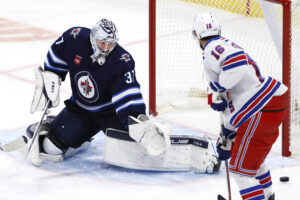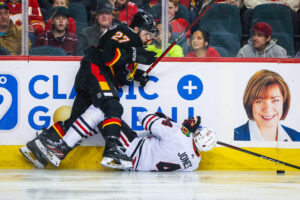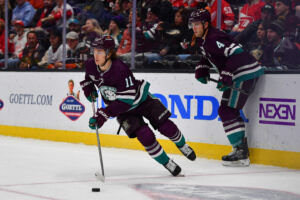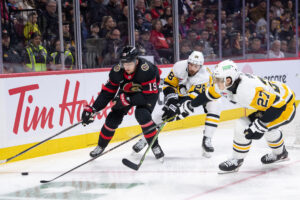Over the last several months, I have been crunching numbers, trying to solve the many questions of NHL draft pick development. With that, we here at Last Word On Hockey will be starting a new series on how to properly develop prospects from all different spots throughout the draft.
Top Three NHL Draft Pick Development
From 2005-2015, there have been 24 draft picks used on forwards from North American junior teams in the top three. The focus was directly on North American prospects for the sake of comparing stats. I separated those 24 forwards from the rest of the top three picks in that span. Then, I looked at their DY-1 stats, the season before they get drafted, and their DY stats. I averaged out their points per game in their DY-1, DY and beyond, if necessary, and colour-coded them. The four sections were “well-above average,” “above average,” “below average” and “well-below average.”
Based on the sections they landed on before they played 15 or more games in an NHL season, they were separated into categories. The categories were “Forwards deemed NHL Ready,” “Forwards nearly NHL Ready,” “Slightly Rushed,” “Rushed,” “Forced,” “Teams were Patient,” and “Teams were way too patient.” There were four forwards who landed in the “teams were patient” category. Those four forwards were Jonathan Toews, Kyle Turris, Jonathan Huberdeau, and Sam Reinhart.
Jonathan Toews
Jonathan Toews, playing out of the NCAA, was notably taken by the Chicago Blackhawks 3rd overall in the 2006 NHL draft. In his DY-1 season, Toews played in the USHS with the Shattuck St. Mary’s U18 team. In that season, he produced at a 1.719 point per game pace, which ranked 1st among top-three drafted forwards playing in North America, in their DY-1 seasons from 2005-2015. However, he did that in a weak league, but despite that, he landed in the well-above-average category for production. In his draft year, he played in the NCAA for the University of North Dakota, where he produced at a 0.929 point per game pace. That production ranked 26th out of the 27 forwards.
He did not get called up immediately to play in the NHL, as he was given an additional year to play NCAA hockey. In his DY+1 season, he recorded a 1.353 point per game season, ranking sixth among eight forwards who had a DY+1 season outside of the NHL. Despite the comparably lower production, Chicago felt they waited long enough for their future number one center.
Jonathan Toews NHL Usage
In his first taste of NHL action, Toews played 64 total games, averaging 18:40 time on ice per game. With that fairly large role, Toews produced an impressive 24 goals and 30 assists for 54 points. As for his advanced analytics, Toews produced an exceptional 12.1 even-strength offence above replacement (EVO) score to go along with a -2.9 even-strength defence above replacement (EVD) score. He also recorded a 3.4 wins above replacement (WAR) and a 19.0 goals above replacement (GAR). As a rookie, those are excellent numbers.
In his sophomore season, he had a slight decline. He played a full 82-game season but averaged 18:38, a very slight dip from his rookie year. He produced 34 goals and 35 assists for 69 (nice) points. Where the decline shows up is in his advanced analytics. He recorded a measly 6.1 EVO, but a far-improved 4.4 EVD score. Along with that, he recorded 2.4 WAR and 13.2 GAR, both slightly below his rookie year totals.
Great Year Three for Toews
In his third season, Toews returned to his excellent rookie year form. He played in 76 games, averaging 20 minutes of ice time per game, a small jump up in his role. With the slight rise, he produced 25 goals and 43 assists for 68 points, and he would’ve surely surpassed his sophomore point totals had he played the full season. As for analytics, Toews recorded a 10.0 EVO and a 5.2 EVD. On top of that, he recorded a remarkable 4.4 WAR and a 24.2 GAR. To put that in perspective, his GAR in his third season was higher than McDavid’s in his third season.
Kyle Turris
Playing in the BCHL in both his DY-1 and draft year, Turris recorded good point production. In his DY-1 season, he averaged 1.263 points per game, landing him in the above-average category for production. In his DY, he improved his numbers, averaging 2.283 points per game, which ranked fourth among the 27 skaters that Toews was compared to above. Despite solid production, albeit in a weak league, Turris was given an additional year of development outside of the NHL. In his DY+1 season, Turris played with the University of Wisconsin in the NCAA and recorded 0.972 points per game. He had a three-game stint at the end of the year with the team that drafted him 3rd overall in 2007, the Edmonton Oilers.
Kyle Turris NHL Usage
As stated earlier, he played a three-game stint following his NCAA season, recording one assist. In his first true taste of the NHL, Turris played 63 games, averaging 12:55 per game, with an additional eight AHL games played. In the NHL, Turris produced eight goals and 12 assists for 20 points. Analytically, Turris had a -1.3 EVO and a -2.5 EVD. Additionally, he recorded a 0.1 WAR and 0.3 GAR. In the eight AHL games, Turris recorded four goals and three assists for seven points. So, despite being below replacement level at even-strength, he was still above replacement level, overall.
Despite being basically a replacement-level player at a very young age, the Oilers thought it would be best to send Turris down for a full season in the AHL. He would play 76 games there, with not a single NHL stint. He recorded 24 goals and 39 assists for 63 points. Instead of the young Turris, Edmonton iced Shawn Horcoff, Ethan Moreau, and Fernando Pisani. Combined, those three forwards had a -6.9 EVO, -9.4 EVD, -3.9 WAR, and -21.9 GAR. It’s safe to say that Turris would not have been worse, and maybe even could have helped improve the team, as the Oilers finished with a record of 27-47-8.
Bounceback Season?
Turris would return to the Oilers roster as a regular, playing in 65 NHL games to just two AHL games, averaging a measly 11:16 average time on ice per game. Despite a very limited role, he would record 11 goals and 14 assists for 25 points. Additionally, he would record a 7.3 EVO and a -3.6 EVD to go along with a 0.6 WAR and a 3.4 GAR. Certainly, those numbers would have been a welcome site as opposed to the numbers any one of Horcoff, Pisani or Moreau provided last season.
Jonathan Huberdeau
Huberdeau, who was drafted 3rd overall in the 2011 NHL entry draft by the Florida Panthers, played in the QMJHL. In his DY-1 season, he recorded 0.574 points per game, which ranked 26th out of the 28 forwards drafted in the top-three from 2005-2015. That performance landed him in the well-below average category for DY-1 production. He followed that up in his draft year with a 1.567 point per game pace, which ranked 19th and landed him in the below-average category.
Huberdeau was not brought up onto the Florida Panthers squad out of the draft, as he instead played another season in the QMJHL. There, he would record at a 1.946 point per game pace, placing him well-above average in terms of production. After a very successful DY+1 season, Huberdeau would get a chance at the NHL level.
Jonathan Huberdeau NHL Usage
Rather than starting the season in the NHL, due to the lock-out, the Panthers would elect to have Huberdeau play 30 QMJHL games, where he produced 16 goals and 29 assists for 45 points. Following those 30 games, he was given 48 NHL games, where he averaged 16:56 time on ice per game. With that role, he recorded 14 goals and 17 assists for 31 points, impressive numbers for the rookie. Along with those counting stats, he recorded a 2.3 EVO, -1.3 EVD, 0.6 WAR and 3.1 GAR. Pretty underwhelming underlying stats, despite the solid production.
Huberdeau’s sophomore season would be a tough one, as he played just 69 games, averaging a smaller role, at 15:40 time on ice per game. He recorded just 9 goals and 19 assists for 28 points in that role. His analytics, however, were much better than his rookie year. He tallied a 4.7 EVO and a -1.2 EVD, to go along with a 1.2 WAR and 6.4 GAR.
Huberdeau’s Breakout Season
In his third season, Huberdeau finally put it all together. He played 79 games, averaging 16:45 of ice time. He recorded 15 goals and 39 assists for 54 points. His analytics were excellent as well, scoring a 9.5 EVO and a -0.2 EVD. On top of his even-strength scores, he recorded a 2.3 WAR and a 12.1 GAR. In his career, Huberdeau won the Calder Trophy, but nothing more.
Sam Reinhart
Reinhart, drafted 2nd overall by the Buffalo Sabres in the 2014 NHL draft, played in the WHL. In his DY-1 season, Reinhart recorded 1.181 points per game, landing him in the below-average category. He ranked 16th out of the previously mentioned 28 skaters. He followed up his DY-1 season with a 1.75 point per game pace in his draft year, landing him in the above-average category. He’s one of just four players out of the 28 mentioned to land in the above-average or higher category in their draft year to not land on an NHL squad out of the draft.
Instead, Reinhart played another year in the WHL, where he declined slightly in production, averaging 1.383 points per game, and landing in the well-below average category. Despite regressing in production, Reinhart was given a shot at the pro level.
Sam Reinhart NHL Usage
Reinhart would play 79 games in his rookie year, averaging 16:50 of time on ice. He went on to record 23 goals and 19 assists for 42 points, which is a solid stat line. His analytics painted an even brighter picture for the youngster, as he would tally a 5.1 EVO, 1.6 EVD, 2.3 WAR and 12.1 GAR. In fact, those analytics are among the best compared to top-three picks in their rookie years in the previously mentioned span of 2005-2015.
In his second season, Reinhart again would play 79 games, with a slight raise in his ice time. This year, he averaged 17:13 of time on ice per game. With the slight rise, Reinhart would produce 17 goals and 30 assists for 47 points. Once again, a solid stat line. His analytics once again were strong, producing a 4.1 EVO, 3.4 EVD, 2.6 WAR and 13.7 GAR.
Despite producing extremely well in his first two seasons, Reinhart, playing in his first full 82-game season, would not see a bigger role. He averaged less ice time, in fact, as it dropped slightly to 17:06 time on ice per game. This time around, he scored 25 goals and 25 assists for 50 points. Yet again, another exceptional stat line. His analytics would dip slightly this year, as he went on to score a 1.8 EVO, 3.3 EVD, 2 WAR, and 10.1 GAR.
Where Are They Now?
Three of the four players are considered top-six players in the league to this day. The lone exception has been Kyle Turris. The misuse of his deployment by Arizona hurt his overall development. He was the only one to see extended time in the AHL or juniors after becoming an NHL regular. He was also the only player to never surpass 13 minutes of ice time in his first three seasons. In fact, outside of Turris, no one averaged less than 15:40 of time on ice per game over a full season.
Turris also saw himself get dealt mid-way through his fourth season within the Coyotes system to the Ottawa Senators. Those were his best seasons, as he was given a top-six role with them for all six seasons he played there. However, he was dealt to the Nashville Predators in the 2017-18 season, and his ice time has diminished ever since. Currently, he plays for the Edmonton Oilers
Reinhart, Huberdeau and Toews
As for the three successful players, here’s what happened. All three still remain with the teams that drafted them. All three were given a big role almost immediately upon joining their teams. Finally, all three watched as their organizations build around them with other excellent pieces. For Reinhart, he saw the Sabres draft Jack Eichel, develop Victor Olofsson, and sign Jeff Skinner and more recently, Taylor Hall. Even though Buffalo is struggling they have grown Reinhart exceptionally well.
For Huberdeau, the Panthers added Aleksander Barkov, Mike Hoffman and Evgenii Dadonov for a couple of seasons, and most recently they added Patric Hornqvist, Carter Verhaeghe and Anthony Duclair. This season, the Panthers finally look like the real deal. They’ve done an excellent job developing Huberdeau, who is one of the most underrated players in the league currently.
Finally, for Toews, he won three Stanley Cups. The Blackhawks built around Toews by adding Patrick Kane, Brandon Saad, Artemi Panarin, Dominik Kubalik, Marian Hossa, Patrick Sharp and more. Again, just like the previous players mentioned, the Blackhawks did an incredible job developing Toews. Not only that, they did a great job building around Jonathan Toews.






